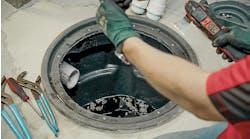DAYTONA BEACH, FLORIDA — Tom Grandy pointed out the obvious. Why do some contracting firms prosper but others don’t go anywhere? It’s not that big a secret but so many contractors don’t take care of a few fundamentals that Grandy’s message is always relevant.
Grandy, who founded Grandy & Associates 28 years ago, told members of the Quality Service Contractors meeting here about the “15 Things All Successful Companies Have in Common.” All of the items were familiar but most people don’t do them.
To begin with, a successful company covers all of its costs of doing business — all of them, including a decent salary for the owner and a retirement plan for the owner and employees. They meet and exceed customer expectations. And they generate a three percent to seven percent pre-tax profit. Most contractors don’t, although the good ones do.
A contractor must know what labor rate must be charged to cover the costs of doing business from a cash flow perspective and to generate a significant pre-tax net profit. This is not, Grandy emphasized, what the contractor would like to charge or what the competition is charging, but what the contractor must charge.
The number one cause of failure, Grandy said, is not recalculating a profitable labor rate on a regular basis. It doesn’t matter if the contractor is HVAC, plumbing, electrical or a landscaper. Most started out as a tech for somebody else. They started out small with little overhead and haven’t recalculated their rates. Overhead goes up as a contractor grows. There are more people, trucks, tools, facilities. By year seven or eight, this turns into a big problem. Labor rates should be recalculated annually.
Contractors often forget to include the cost of non-billable time, full amounts of loan payments and the replacement costs of equipment. Non-billable time is typically four hours a day per plumber, easily more than $20,000 per year per person. If you take out a loan for X dollars, the total dollar value of payments over time must be included in overhead. And while your accountant will take care of depreciation of your vehicles for tax purposes, you have to consider the replacement cost five years from now. If you paid $25,000 for a vehicle now, what will you have to pay to replace it in 2021? How much do you have to charge to cover that?
After all costs are calculated, you must add in your desired net profit. For example, if costs equal $200 per hour and you want a 10 percent net profit, divide 200 by 0.9, which equals $222.22.
Contractors must develop a cash flow budget and track cash flow monthly. Your accountant will tell you to spend cash to avoid taxes. If your monthly projections, however, show that you’ll have five months of losses during slow cycles, you need to have cash on hand to cover that.
Contractors need to create a business plan, and it’s not just for the benefit of your banker, Grandy told the QSC members. A business plan makes you think about what you’ll need in the next year in terms of money and people. A business plan will spell out what you need in terms of labor, new equipment, cash flow and other required funding. Make your banker a friend, Grandy advised and share your business plan with him when you don’t need money.
If you get a line of credit, use it periodically, he advised. If you need it, pay it back within 12 months. If you don’t need money, put the loan money in a savings account in another bank and then pay the loan off in two or three months. Banks like to see activity like that. If you never use the line of credit, your bank may revoke it.
Create a marketing plan that includes results. What will it include and how will it be timed? How much money will you spend? How many leads will you generate from spending that money?
Track where leads are coming from. You have to know what’s works and what doesn’t. Use continuous and overlapping marketing programs to eliminate slow times. When your customers think about your products, they must think of you. Why don’t happy customers call you? They’ve forgotten about you. Use equipment stickers and good refrigerators magnets (a good magnet can hold four pieces of paper; bad magnets go in the trash). Branded chip clips will cost you about 18 cents a piece.
Create an organizational plan. An organizational plan shows your employees that there’s a future for them. Train them for that future. It helps retention.
Create a “brag book.” A brag book should include referrals from past customers with comments, copies of insurance certificates, pictures of past jobs, pictures of your building and people, lists of associations to which you belong, licenses and product literature. Sell yourself, sell your company, Grandy advised.
Plan for growth. Contractors often hit bumps when revenues reach $1 million, and then again at $2.5 million and $5 million.
Send an annual letter to your customer base reminding them about everything you can do for them. Create a newsletter and send it at least twice a year. Four times a year is better.
Create a maintenance agreement department and bill agreements monthly. The cash flow is good, they reduce non-billable time and guarantee repair work all year long. The customers are happy because maintained equipment doesn’t break down, and when equipment wears out, you get the replacement sale.
“Maintenance agreements are the foundation for profitable growth,” Grandy said.
Network with other contractors, but vet them carefully first. If you recommend an electrician or house painter, they have to be good because their performance will reflect on you. Hand out each other’s literature. Do home shows together and split the cost.
Get involved in a mix group with non-competing contractors and meet with them two to four times a year. Share ideas and solve mutual problems.
Plan for growth. Contractors often hit bumps when revenues reach $1 million, and then again at $2.5 million and $5 million. The transition through $1 million is bumpy because the owner has to come out of the field and become a full time manager. All by itself, that will require an $8-$12 per hour increase in your rates to cover the owner’s salary. You’ll begin to hire middle managers. You might outgrow your accounting system. You need software that includes customer history, controls inventory and that can break your P&L into different departments.
Use flat rate or upfront pricing. Institute a formal training or continuing education program. Create a formal customer service program that includes customer response postcards and happy calls. All of these steps are nothing new, but they remain essential.


